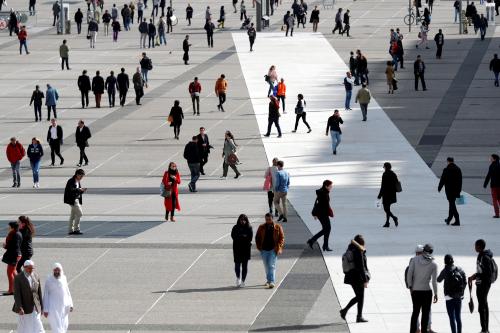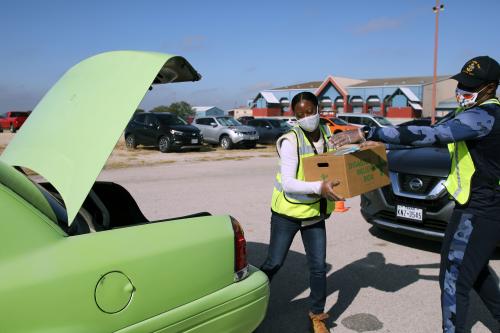If you want more content like this, subscribe to our newsletter.
This week in Class Notes:
-
- As income and wealth inequality grew over the last four decades, taxes have become less progressive. In 2018, the top 1% of earners received 19% of pre-tax U.S. income and the top 0.1% wealthiest individuals held 18% of all wealth.
- Single parents spend a higher proportion of their income on kids compared to married and cohabiting parents. Controlling for income, cohabiting parents spend the least among white families.
- Food stamps are associated with increased political participation among young adults who don’t pay close attention to politics.
- This week’s top chart shows that among all parents, single moms faced the sharpest decline in employment from a year ago.
- In this week’s choice opinion, Melinda Gates argues that the Biden administration should appoint a caregiving czar, push to fund the child-care industry, and allocate resources to clear Medicaid’s long-term care waitlist.
- Finally, check out our latest piece on race gaps in SAT math scores and policies to remedy their effect.
Escalating wealth and income inequality
It is well known that inequality has increased in the last few decades. But by how much? What are the differences between wealth and income? How far do taxes dampen the impact of market inequalities? These are the questions Emmanuel Saez and Gabriel Zucman set out to answer. In the last 40 years, wealth has grown at twice the rate of income; in 1980, the top 1% owned wealth equal to 60 times the average U.S. income. In 2020, the top 1% owns wealth equal to 200 times the average U.S. income. A similar trend holds for the top 10% wealthiest individuals, who owned 67% of total wealth in 1989, but 77% in 2018. Saez and Zucman also find that the effective individual income tax has become much less progressive, and in fact quite regressive at the top end of the distribution.
Single parents spend the largest portion of their income on their children
Using Consumer Expenditure Surveys from 2013-2018, Orestes Hastings and Daniel Schneider investigate differences in financial investments in child care, schooling, and children’s enrichment activities by family structure—married, cohabitating, or single. Married parents (unsurprisingly) spent the most on their children overall, followed by cohabitating parents, then single parents. But as a proportion of household income, single parents spend the most, and cohabiting parents spend the smallest proportion of their income, a trend mostly driven by white cohabiters; Black and Hispanic cohabiting parents spent about the same as married Black and Hispanic parents, after controlling for income. The spending gaps are widest among those with 4-year degrees and in white households.
Cash assistance programs may actually encourage political participation
Do cash assistance programs politically alienate or incorporate participants? In contrast to earlier research, Naomi Sugie and Emma Conner find little evidence that participation in cash assistance programs (like welfare) deters political participation overall. But there are differences by sub-group, especially in terms of prior levels of interest in politics and government. Using a sample of young adults (ages 19-29) from the National Longitudinal Survey of Youth 1997, they find that food stamps are positively correlated with being registered to vote among those who pay less attention to government affairs. Among more attentive young adults, food stamps decreased the likelihood of voting or being registered to vote.
Top chart: Unpartnered moms saw the largest employment drops among parents
This week’s top chart shows that employment among single mothers dropped by 9 percentage points compared to a year ago—the steepest decline among parents. By contrast, single dads saw a 4-percentage point decline, similar to that of partnered moms and dads who each experienced a 5-point drop.

Choice opinion: Our caregiving system is broken
“The coronavirus has laid bare what was painfully clear to many families already: The caregiving system in the United States is broken, and it is women who are paying the price. Even before the pandemic began, child care and long-term care solutions were often unaffordable and inaccessible, and women were filling the gaps at tremendous cost to their own economic potential. Now, with child-care centers closed, schools operating remotely, and families caring for sick adults and aging parents at home, what was previously untenable has become almost impossible — especially for single mothers, essential workers and others working low-wage jobs with unpredictable hours,” writes Melinda Gates in the Washington Post.
Self-promotion: SAT math scores mirror and maintain racial inequity
The SAT was created to give talented students—regardless of income—the chance to compete for college admission and scholarships. Nearly 100 years later, the test often excludes the lower-income students it was designed to help. In our latest piece, Richard Reeves and I investigate the class of 2020’s SAT math scores and discover startling gaps by race. Fewer than a third of Black or Hispanic or Latino test takers met the college readiness benchmark in math, compared to 59% and 80% of white and Asian test takers. A similar trend holds at the top end of the score distribution—among all students scoring in the top 10% on the math section, fewer than 10% are either Black or Hispanic or Latino. Progress in narrowing the gap has been painfully slow; addressing racial inequities in education will require earlier childhood interventions and providing admissions committees with more background context when considering SAT scores.






Commentary
Class Notes: Rising income and wealth inequality, parent spending, and more
December 9, 2020